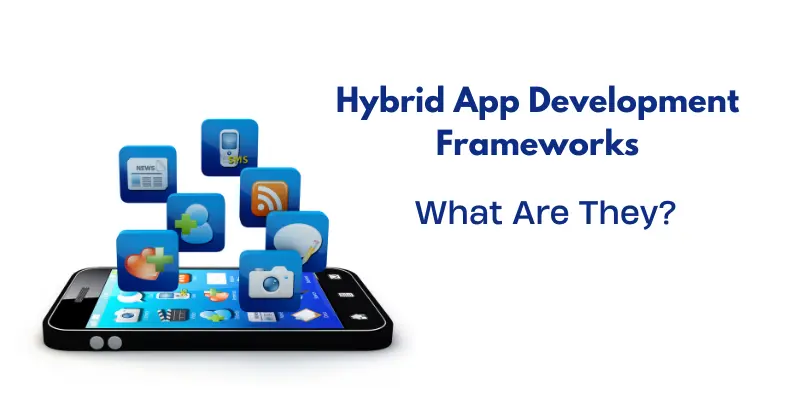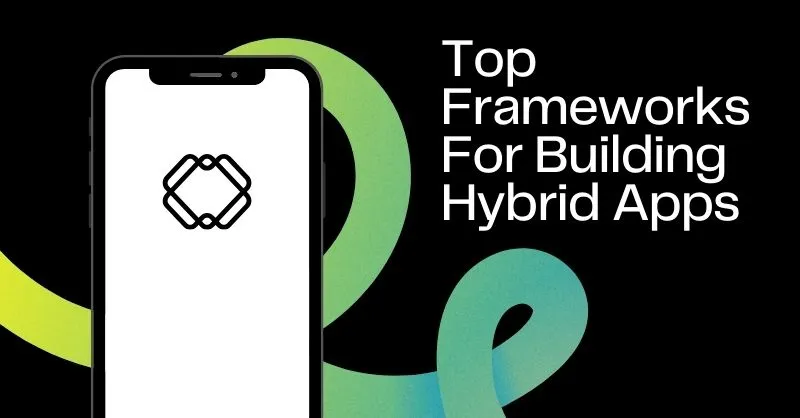Top Frameworks For Building Hybrid Apps

The simplicity of use for developers has increased dramatically with hybrid mobile app development frameworks. Instead of having to put in the extra effort to write unique code for each platform, they can create applications that run flawlessly across all platforms with only one code. These apps function flawlessly on iOS and Android and may be recycled for desktop or progressive web apps.
Therefore, in this section, we’ll go over the fundamentals of hybrid apps and compile a list of some of the top frameworks for hybrid apps that have grown in popularity over the past several years.
How do hybrid apps work?
Web apps are basically hybrid apps. They are the ideal fusion of online and native applications. the essential components of a web application, but it is given a native app’s container, enabling it to have native app capabilities and hardware.
The same code can be used by developers for all operating systems with the ease with which hybrid apps can be downloaded on several platforms, including iOS and Android. Effective front-end development technologies like HTML5, JavaScript, and CSS are used in their construction.
The Distinction Between Native and Hybrid Apps
nevertheless, some notable distinctions between the two. Let’s talk about that.
• While hybrid apps are made to work on several platforms, native apps are made just for one.
• When creating native apps, developers must completely rethink and redesign each feature in the native language. In contrast, all of the functionality of hybrid apps is written in a single codebase.
• The cost of developing a native app is significantly more than that of developing a hybrid app, which is more affordable and offers an excellent user experience.
Hybrid App Development Frameworks: What Are They?
Software tools known as hybrid app development frameworks let programmers design apps that function flawlessly across a range of operating systems. These frameworks have a single codebase and are designed to let web apps and native apps work together.

Best Frameworks for Developing Hybrid Apps
The following is a list of some well-known frameworks for developing hybrid apps:
1. Ionic
Among the widely used frameworks is Ionic. It is a free and open-source framework for creating hybrid mobile apps that comes with a ton of services and tools for front-end and back-end development, such as HTML5, CSS, JS, and Sass. All developers concur that Ionic offers the ideal ecosystem of goods and services and is a simple framework to learn, which ultimately gives developers more control.Progressive Web Apps (PAWs) can be simply created with Ionic thanks to its extensive front-end development library and outstanding user interface capabilities, which work together to create the best PWAs. With excellent UI elements and gestures, this framework boasts over 120 native device functionalities, like as Bluetooth, Cordova, HealthKit, and more. Sworkit, Justwatch, and McDonald’s Turkiye are a few apps that make use of Ionic.
2. Fluster
According to Google, Flutter aspires for a native-like experience while giving you control over your projects via a UI toolkit. Flutter is able to create amazing user interfaces for various platforms using a single codebase. This framework has its own library of user-friendly UI elements, known as widgets, and was created in the Dart programming language.
Widgets can be customized by developers to meet the specific needs of each project.
Flutter’s ability to compile apps to native machine codes, which produces outstanding run-time performance, is one of its best features. Developers can see their code changes instantly with Flutter because to its reloading capability. They may debug, repeat, and improve programs while they’re being developed with this functionality, saving them from having to start over. This framework offers highly adjustable platform themes and is free of charge.
3. Native React
Facebook is the developer and maintainer of the React Native technology. It’s a framework that lets you create mobile applications with just JavaScript. It has a user interface development language called JSX and is used to create cross-platform applications.
Its designs are identical to React’s, and you may use declarative components to create an excellent user interface. Instead of giving you a mobile web app or a hybrid app, this framework creates a mobile app that is nearly equivalent to those made with Java or Objective-C.
Several prominent brands, including as Airbnb, Tesla, Amazon Prime, and Skype, are among the top examples of React Native applications. Its connectivity with third-party plugins, reusable components, and component-oriented GUI development for front-end applications are a few of the factors contributing to its growing popularity. online app developers may now transform their existing online apps to mobile apps with React Native.
4. Xamarin
Microsoft purchased Xamarin, a very intelligent and potent framework for developing cross-platform apps. Prior to the tech company’s acquisition in 2016, it was a community project. The framework uses a single codebase approach and is developed in C# to enable the development of native-looking Windows, iOS, and Android apps.
Developers can save time and resources by using a large portion of the codebase for many platforms, thanks to Xamarin. Xamarin is unique in that it can natively integrate libraries for Objective-C, C++, and Java. Developers select React Native and Xamarin over one another when building a creative website on a tight budget.
All that has to be done to install Xamarin is download and run the Xamarin installer. They may create a robust ecosystem with APIs, components, back-end, libraries, and programming languages supported by a vibrant community by utilizing this architecture.
5. User Interface Kendo
As a JavaScript UI framework, Telerik (the parent company of Ash NativeScript) created Kendo UI. It is a feature-rich, open-source framework that is well-known for its sophisticated operations and multi-framework compatibility. It includes jQuery, Angular, React, and Vue libraries to make the ideal hybrid mobile application.
This framework’s main goal is to enable developers to create robust, high-caliber hybrid applications for enterprise customers. The finest things about Kendo are the outstanding assistance it offers and the way it ensures that each component has rigorously gone through their quality assurance procedure.
Among the more than 140,000 clients of Kendo are well-known companies like NASA and HP. The framework is abundant in ready-to-use widgets and does not offer a free version. It is considered the ideal framework for developing hybrid apps because it can be used to create HTML5 mobile apps and works seamlessly on popular smartphone platforms.
6. Framework 7
Framework7 can be the best option if you want to create hybrid mobile apps, web apps, or PWAs with a native-like user interface. With its quick and reliable features, this open-source mobile HTML framework is a great option for Windows, Mac, the web, Android, and iOS.
Its design-first methodology results in pre-made designs and components that you can customize to your preference. It offers support for Svelte, React, and Vue.js. Framework 7’s compelling user interface, which includes side panels, popups, layouts, and more, is its standout feature.
Frameworks for developing hybrid apps offer countless benefits that you may take use of. It can be challenging to select a framework for your mobile application. The best framework for you will depend on how you compare your options and take into account each one’s unique features. This is something that hybrid app developers can handle for you. Digital Gravity has a skilled staff that creates scalable, engaging, and interactive mobile apps for customers all over the world.
Top Frameworks for Developing Applications that are Hybrid
Frameworks for developing hybrid mobile apps have significantly improved developer ease of use. They can write programs that work flawlessly on all platforms with a single code, saving them the added work of writing different code for each platform. These apps may be recycled for desktop or progressive web apps, and they work perfectly on iOS and Android.
As a result, we’ll cover the basics of hybrid apps in this section along with a list of some of the best frameworks for hybrid apps that have been more and more popular in recent years
How do apps that are hybrid operate?
In essence, web apps are hybrid apps. They are the perfect combination of native and web applications. the basic parts of a web application, but its container is that of a native app, giving it access to hardware and native app capabilities.
The same code may be used by developers for multiple platforms, including iOS and Android, with the same simplicity that hybrid apps can be downloaded. They are built using efficient front-end development tools such as HTML5, JavaScript, and CSS.

The Differences Between Hybrid and Native Applications
Why do native and hybrid apps sound so alike now, you must be wondering. Nevertheless, there are a few noteworthy differences between the two. Let’s discuss that.
• Native apps are designed for a single platform, whereas hybrid apps are intended to run on many platforms.
• Developers have to rethink and reinvent every feature in the native language when making native apps. In contrast, hybrid applications have a single codebase that contains all of its features. Creating a hybrid app is less expensive and provides a better user experience than creating a native app, which is far more expensive.
Top Frameworks for Creating Hybrid Applications
Some well-known frameworks for creating hybrid applications are listed below:
1. Ionic
Ionic is one of the popular frameworks. It is an open-source, free framework for developing hybrid mobile applications that includes a plethora of front-end and back-end development services and tools, including HTML5, CSS, JS, and Sass.
Every developer agrees that Ionic provides the best possible ecosystem of products and services and is an easy-to-learn framework that eventually allows developers more power.
Ionic’s robust front-end development toolkit and exceptional user interface features make it easy to construct Progressive Web Apps (PAWs), and when combined, they provide the best PWAs.
This framework includes over 120 native device features, including as Bluetooth, Cordova, HealthKit, and others. It has top-notch UI components and animations. A few apps that employ Ionic are Sworkit, Justwatch, and McDonald’s Turkiye.
2. Fluster
Google states that Flutter uses a UI toolkit to give you control over your projects and an experience that is similar to native apps. With just one codebase, Flutter can produce stunning user experiences for a variety of platforms. This framework was developed in the Dart programming language and includes its own collection of user-friendly UI elements, or widgets. Developers can alter widgets to suit the unique requirements of each project.
One of the best things about Flutter is its ability to compile apps to native machine instructions, which results in exceptional run-time performance. Because Flutter can reload itself, developers can see their changes to the code instantaneously.
With this functionality, they may make improvements, repeat, and debug programs while they’re being produced, avoiding the need to start from scratch. This framework is free of cost and provides highly customizable platform themes.
3. Native React
The React Native technology is developed and maintained by Facebook. With just JavaScript, you can construct mobile applications using this framework. It is used to construct cross-platform apps and contains a user interface development language called JSX.
Its designs are exactly the same as React’s, and you can make a great user experience with declarative components. This framework produces a mobile application that is almost identical to those developed using Java or Objective-C, as opposed to providing you with a mobile web app or a hybrid app.
Here are some of the best examples of React Native applications: Airbnb, Tesla, Amazon Prime, Skype, and other well-known businesses. A few of the elements boosting its rising popularity are its interoperability with third-party plugins, reusable components, and component-oriented GUI development for front-end applications. With React Native, online app developers can now convert their current web apps to mobile apps.
Disclaimer: Above all information is for general reference only and sourced from internet, before making any kind of decision please visit the authorized websites of authorities and service providers.

